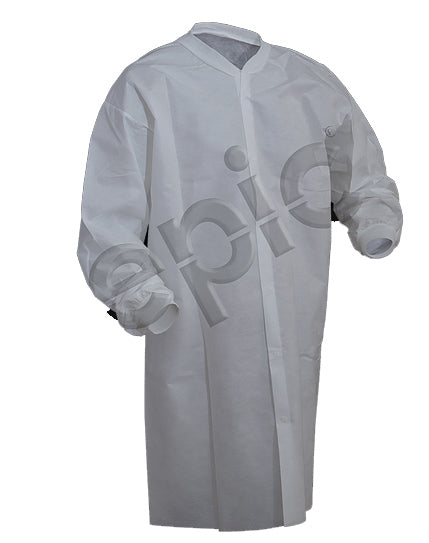- No products in the cart.
Navigating the world of laboratory apparel can be a daunting task, with a myriad of options available to suit different needs and preferences. One of the most significant decisions facing lab workers and managers is whether to opt for disposable lab coats or laundered reusable lab coats. Both options have their own merits and drawbacks, making the choice a delicate balance of cost, and contamination control.
Why Use Disposable Lab Coats?
Disposable lab coats offer a compelling combination of benefits that make them a preferred choice for many laboratory settings. Their single-use nature eliminates the need for laundering and sterilization, a significant advantage in terms of both cost and convenience. This cost saving is particularly evident in high-volume cleanroom environments where frequent use of lab coats is the norm.
Another crucial advantage of disposable lab coats lies in their superior contamination control capabilities. Each disposable lab coat serves as a fresh barrier, ensuring that it is free from any contaminants that may have accumulated on reusable lab coats during previous uses. This single-use feature minimizes the risk of cross-contamination and provides a consistently high level of protection for each wearer.

Drawbacks of Laundered Reusable Lab Coats
While laundered reusable lab coats initially appear as a cost-effective option due to their reusability, they come with several drawbacks that make them less desirable in comparison to disposable lab coats.
One major concern is the risk of cross-contamination during the laundering process. Reusable lab coats may come into contact with other contaminated items during the washing and drying cycle, increasing the likelihood of spreading contaminants. This risk is particularly acute in sensitive laboratory environments where contamination control is paramount.
Additionally, the repeated laundering of reusable lab coats can compromise their integrity over time. The materials used in reusable lab coats may break down or wear out, leading to reduced barrier protection and an increased risk of contamination. This deterioration necessitates frequent replacement, further increasing the overall cost of using reusable lab coats.
Laundered Lab Coats - Tradition, Longevity, and Environmental Considerations
Tradition and Longevity
Laundered lab coats have long been the traditional choice in many laboratory settings. The durable and reusable nature of these coats may appeal to those who value a more sustainable and long-term solution. However, this longevity comes with associated costs and considerations that merit attention.
Over time, laundered lab coats undergo wear and tear due to repeated washing, resulting in a shorter lifespan. The depreciation and replacement costs associated with laundered lab coats can accumulate, potentially surpassing the initial investment required for disposable alternatives. While tradition plays a role in the preference for laundered lab coats, it's essential to evaluate whether this choice aligns with modern cost-effective and environmentally conscious practices.
Environmental Considerations
From an environmental standpoint, laundered lab coats raise concerns regarding water, energy, and detergent consumption. The ecological footprint associated with the repeated laundering of lab coats may conflict with sustainability goals. In contrast, disposable lab coats, with their reduced environmental impact, offer a more eco-friendly option for laboratories aiming to minimize their carbon footprint.
Industries Best Suited for Disposable Lab Coats
Given their inherent advantages, disposable lab coats are particularly well-suited for industries where contamination control is of utmost importance. These industries include:
-
Pharmaceutical Manufacturing: In the pharmaceutical industry, where the purity and sterility of medications are critical, disposable lab coats provide the highest level of contamination control, ensuring that no contaminants are introduced during the manufacturing process.
-
Medical Research: Medical research often involves handling hazardous substances and infectious agents. Disposable lab coats offer the necessary protection for researchers, preventing exposure to these risks.
-
Semiconductor Manufacturing: The semiconductor industry demands a pristine environment to prevent defects in microchips. Disposable lab coats help to maintain this cleanliness by preventing the introduction of dust and particles.
-
Food Processing: Food processing facilities must adhere to strict hygiene standards to prevent contamination of food products. Disposable lab coats help to maintain these standards by preventing the spread of bacteria and other contaminants.
Conclusion
The choice between disposable lab coats and laundered reusable lab coats is not a one-size-fits-all decision. While laundered reusable lab coats may offer an initial cost saving, their drawbacks in terms of contamination control and potential for cross-contamination make them less suitable for many laboratory settings. In contrast, disposable lab coats provide superior contamination control, eliminate the risk of cross-contamination, and are often more cost-effective in the long run, especially in high-volume cleanroom environments. As sustainability concerns grow, the development of more eco-friendly disposable lab coats is further enhancing their appeal. Ultimately, the decision hinges on the specific needs and priorities of the laboratory environment, with disposable lab coats emerging as the preferred choice for many industries where contamination control is paramount.
For over 40 years, Lab Pro Inc. is your steadfast source for premium cleanroom lab supplies, hand tools, lab equipment, chemicals, and PPE apparel. Trusted by aerospace industries, medical device companies, and laboratories globally, we epitomize exceptional quality in every product. Experience the convenience of next day service in California. Contact us online or at 888-452-2776 to explore solutions tailor-made for the laboratory industry. Elevate your experiments with Lab Pro Inc. – your partner in precision and excellence.












































